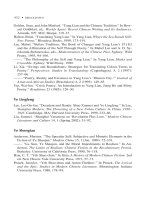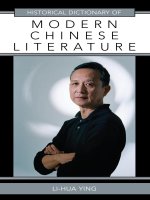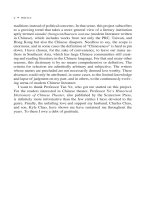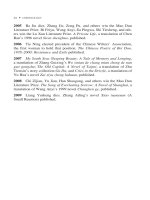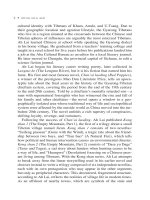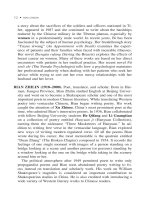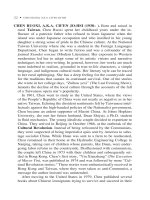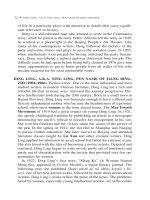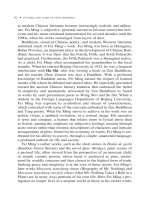"Historical Dictionary of Modern Chinese Literature" by Li-hua Ying - Part 3 pptx
Bạn đang xem bản rút gọn của tài liệu. Xem và tải ngay bản đầy đủ của tài liệu tại đây (93.05 KB, 10 trang )
2005 Ba Jin dies. Zhang Jie, Zong Pu, and others win the Mao Dun
Literature Prize. Bi Feiyu, Wang Anyi, Jia Pingwa, Shi Tiesheng, and oth-
ers win the Lu Xun Literature Prize. A Private Life, a translation of Chen
Ran’s 1996 novel Siren shenghuo, published.
2006 Tie Ning elected president of the Chinese Writers’ Association,
the first woman to hold that position. The Chinese Poetry of Bei Dao,
1978–2000: Resistance and Exile published.
2007 My South Seas Sleeping Beauty: A Tale of Memory and Longing,
a translation of Zhang Guixing’s Wo sinian de chang mian zhong de nan
guo gongzhu; The Old Capital: A Novel of Taipei, a translation of Zhu
Tienxin’s story collection Gu Du; and Cries in the Drizzle, a translation of
Yu Hua’s novel Zai xiyu zhong huhuan, published.
2008 Chi Zijian, Yu Jian, Han Shaogong, and others win the Mao Dun
Literature Prize. The Song of Everlasting Sorrow: A Novel of Shanghai, a
translation of Wang Anyi’s 1999 novel Changhen ge, published.
2009 Liang Yusheng dies. Zhang Ailing’s novel Xiao tuanyuan (A
Small Reunion) published.
xx • CHRONOLOGY
xxi
Modern Chinese literature has been flourishing for over a century, with
varying degrees of intensity and energy at different junctures of history
and points of locale. It is solidly an integral part of world literature, for
from the moment it was born, it has been in dialogue with its counterparts
from the rest of the world. As it has been challenged and enriched by ex-
ternal influences, it has contributed to the wealth of literary culture of the
world. Gone are the days when a Western reader picked up a book of mod-
ern Chinese literature for nonliterary reasons and when Chinese novels
or poems were treated as sociopolitical documents. Nowadays, it is more
likely that readers appreciate a Chinese novel because it is a great piece
of art, not simply because it provides knowledge and information about
Chinese society and politics. Indeed, the best literature written in Chinese
is on a par with the best literature written in any other language; this has
been especially true during the past three decades, which have given us
some internationally recognized names, even a Nobel laureate. In terms of
themes and styles, modern Chinese literature is rich and varied: from the
revolutionary to the pastoral, from romanticism to feminism, from mod-
ernism to postmodernism, critical realism, psychological realism, socialist
realism, and magic realism, you name it. Indeed, it encompasses a full
range of ideological and aesthetic concerns.
In some ways, what gives modern Chinese literature its vibrant diver-
sity is its geographic range. Here the term Chinese literature should not
be mistaken for “literature of China”—although the People’s Republic of
China (PRC) itself is already a mind-boggling size—for its creators and
readers are widely spread all over the globe. It is not an exaggeration to
say that where there are Chinese communities, there is Chinese literature
being read and written. Beyond the borders of China, Taiwan, and Hong
Kong, there is a whole population of Chinese writers scattered throughout
Southeast Asia, Europe, and North America who are connected in their
Introduction
love of the Chinese language as the medium of artistic expression. This is
the landscape of Chinese literature today.
In the study of Chinese history, modern China is generally divided into
three periods: jindai (the recent era), 1840–1911; xiandai (the modern
era), 1911–1949; and dangdai (the present era), 1949 to the present. The
curtains of the jindai era were forced open by guns and cannons of West-
ern forces in the mid-19th century. During the next six decades, the Qing
dynasty (1644–1911) lost the Opium Wars to Great Britain, its navy was
soundly defeated by Japan, and its territories were ceded to the Europeans,
Russians, and Japanese. Although the Republican Revolution led by Sun
Yat-sen succeeded in overthrowing the feeble and corrupt Qing empire
and established the Republic of China in 1911, civil wars put the young
republic in grave danger and the country continued to be dominated by
foreign powers. Popular discontent reached a boiling point in 1919, when
the Versailles Conference transferred the German concessions in Shan-
dong to Japan, instead of returning them to Chinese sovereignty, causing
widespread protests that later developed into a full-blown cultural cru-
sade known as the May Fourth Movement. A nationwide soul-searching
ensued, led by progressive intellectuals who blamed China’s weakened
state on its fundamental cultural institutions that in their view had become
obsolete and incapable of dealing with the modern world. For the survival
of the Chinese nation, they argued, Western ideas and practices, includ-
ing literature, had to be imported. In this Westward-looking environment,
science and democracy became coded terms that represented modernity,
progress, and hope for a national salvation.
Prior to the 1980s, most literary scholars tended to adopt the same
categories established by historians and saw the May Fourth Movement,
which dominated Chinese intellectual discourse in the 20th century, as
the force behind the emergence and development of China’s literary
revolution. The term widely used to describe the literature born out the
May Fourth Movement is xin wenxue (new literature). Wang Yao in his
Zhongguo xin wenxue shi gao (A History of Chinese New Literature) em-
phasized the umbilical relationship between the new literature and the May
Fourth Movement and puts “anti-imperialism” and “anti-feudalism”
at the
forefront of not only the political and cultural but also the literary agenda.
1
Agreeing with Wang, Qian Liqun, Tang Tao, and Yan Jiayan also regarded
1949, when the PRC was established as a watershed, but they preferred the
more evocative term xiandai wenxue (modern literature).
2
Most scholars in
Taiwan, however, do not see 1949 as such a defining moment. Zhou Jin, in
xxii • INTRODUCTION
his book Zhongguo xin wenxue jian shi (A Brief History of Chinese New
Literature), which was published in 1980, used the term xin wenxue but
expanded it to cover works written in the 1970s by writers in Taiwan and
Hong Kong.
3
In the mainland, the term dangdai wenxue was used widely
in the period since 1949. To account for the new trends of literary creativ-
ity since the late 1970s made possible by Deng Xiaoping’s reform policies,
another category xin shiqi wenxue (literature of the new era) has also been
widely circulated.
Since the 1980s, however, various attempts have been made to bypass
these fragmenting periodizations. Huang Xiuji and his colleagues chose
a calendarian term that not only expands the historical but also the geo-
graphical scope to include literature published outside the mainland.
4
Fol-
lowing a similar model, Chen Liao and Cao Huimin take one step further
to argue that the inception of modern Chinese literature should be traced
to the end of the 19th century.
5
They consider the publication of an article
by Qiu Tingliang (1857–1943) in 1898 a seminal event. Qiu’s article,
entitled “lun baihua wei weixin zhi ben” (The Vernacular Language as
the Basis of the Reform Movement), called for a radical change in the use
of language, a proposal echoed by social reform advocates such as Liang
Qichao (1873–1929), who promoted the genre of fiction, elevating its sta-
tus to that of poetry and prose, the privileged forms in classical Chinese
literary tradition, and Huang Zunxian (1848–1905), who campaigned
for a new kind of poetry that favored wo shou xie wo kou (direct expres-
sion). Chen and Cao contend that the work of these forerunners who had
pushed for a new kind of language and literature eventually led to the
full-blown literary revolution resulting in the publications in 1918 of the
first significant modern Chinese short story “Kuangren riji” (Diary of a
Mad Man) by Lu Xun, and vernacular poems by Hu Shi, Liu Bannong,
and others, ushering in a new era of cultural and literary reform. Helping
to shift the attention from political and social factors to the intrinsic nature
of literature are Rene Welleck and Austin Warren, whose work A Theory
of Literature has influenced the thinking of many Chinese literary histo-
rians.
6
As early as 1985, Chen Sihe called for a redirection in the study
of the history of modern Chinese literature,
7
setting off a new round of
debates in Chinese scholarly circles. Conceptualized in such a framework,
the term xiandai wenxue has found traction, pushing out xin wenxue and
dangdai wenxue.
Outside the Chinese-speaking world, the term modern has been used
widely and loosely. C. T. Hsia, in his groundbreaking book published in
INTRODUCTION • xxiii
1971, A History of Modern Chinese Fiction, examines works from 1917
to 1957 and in the epilogue deals with works that were published through
the 1970s.
8
The English anthology edited by Joseph S. M. Lau and How-
ard Goldblatt published in 1995 defines modern as 1919 to the end of the
20th century.
9
Relatively removed from the China-centric view held by
most literary historians in China, scholars outside the mainland tend to
regard the production of Chinese literature as a global affair that resulted
from migration and immigration. Recent years have seen major efforts
to rewrite the history of modern Chinese literature to take into account
authors in the Chinese diaspora beyond the three major regions of China,
Taiwan, and Hong Kong. Leading the group that attempts to grapple with
the complexity of the field are Dominic Cheung, David Der-wei Wang,
and Shu-mei Shih, who have proposed, each with his or her own empha-
sis, a new conceptualizing framework and terminology: Huawen wenxue
(Chinese-language literature) or Sinophone literature.
10
Regardless of the differences in opinion held by literary scholars,
all agree that modern Chinese literature emerged in the midst of grave
anxieties as a result of China’s encounters with the West, whose advanced
technology and superior weaponry forced Chinese intellectuals to reflect
on their own venerated traditions, both social and literary, and to seek
changes that would meet the needs of a new society. In this campaign
for comprehensive social transformation, literature was at the forefront.
Modern Chinese writers abandoned wen yan (literary Chinese), the lin-
gua franca of Chinese writing, and replaced it with bai hua (vernacular
Chinese) as the language of both prose and poetry. Free verse instead of
regulated verse was the preferred form; an interest in critical realism gave
modern fiction writing its new style and subject matter that was firmly
rooted in the present; and hua ju (spoken drama) made its debut, carving
an important niche in the Chinese theater traditionally monopolized by the
operatic variety.
As educated Chinese wrestled with problems concerning social, political,
linguistic, and literary reforms, the introduction of Western literature into the
intellectual and popular discourses played a crucial role in fundamentally
changing the direction of modern Chinese literary development. Transla-
tions of Western writings, including philosophical, scientific, and literary
texts, influenced a whole generation of Chinese writers, giving rise to a new
literature characterized by its use of the vernacular language as the medium
of expression and its humanistic focus on contemporary social issues. Pain-
fully aware of China’s reduced status, the May Fourth intellectuals located
xxiv • INTRODUCTION
the roots of their country’s plight in the Chinese traditions, particularly Con-
fucianism, which, in their view, had run its course and become a repressive
yoke to the nation, preventing it from competing in the modern world. The
bankruptcy of traditional values thus created a vacuum, making Western con-
cepts of individualism and personal emancipation a welcome replacement in
a culture eager to shed the burdens of its own past. With its devotion to the
cause of national salvation, Chinese literature during the first half of the 20th
century actively engaged itself with various social and political causes, as
China underwent devastating turmoil, including civil wars and the Japanese
invasion. While critical realism, which was perceived as best equipped to ad-
dress contemporary sociopolitical problems, dominated the field, other trends
also prevailed. Shen Congwen’s pastoral representations of his hometown, a
natural society indifferent to moralistic restrictions of Confucian ethics and
modern urban materialism, Zhang Ailing’s stylized prose that probes the dark
side of the human psyche, Shi Zhecun’s introspective narratives, Li Jinfa’s
symbolist poems, and Zhang Henshui’s romantic novels coexisted with
mainstream writings by Lu Xun, Mao Dun, Ba Jin, and a cohort of socially
conscious writers.
In 1949, when the Nationalist government retreated to Taiwan and the
mainland was taken over by the Communists, the May Fourth literary tra-
dition branched off in several directions. Although Taiwan under Japanese
occupation had seen some Chinese literary activities, it was the arrival of
the Nationalist government that turned the island into a bastion and center
of Chinese literary creation. With its close ties to the West, the govern-
ment tolerated a certain degree of creative latitude, provided that writers
stayed within the boundary of aesthetics. In this environment, the modern-
ist movement that had flowered on the mainland from the 1920s to the
early 1940s was resuscitated in Taiwan. Acting as a link between the two
eras were veteran poets such as Ji Xian, a passionate proponent of modern
poetry in the mainland, who became a principal player in modernizing the
field of poetry making in Taiwan. Pumping new blood into the modernist
movement was a younger generation of writers associated with the literary
journal Xiandai wenxue (Modern Literature), which Bai Xianyong and his
friends founded in 1960 on the campus of National Taiwan University.
Challenging this Western-inspired trend,
the xiangtu (nativist) literature,
which rose from the south of the island, insisted on local experience and
the realist mode of expression.
Hong Kong, with its unique geopolitical position and the sudden influx
of talents fleeing Communist China, developed its own brand of literature
INTRODUCTION • xxv
that reflects the realities of the British colony. Representing the continued
experiment with Western modernism was Liu Yichang, who drew on the
stream of consciousness technique to bring to life the sense of rootlessness
and uncertainty in a city living on borrowed time. At the other end of the
spectrum, popular forms of literature thrived; prominent among them were
the martial arts novels of Liang Yusheng and Jin Yong, and Ni Kuang’s
science fiction, which met the needs of readers looking for escape from
the pressures of life in a fast-paced modern city. Meanwhile, in the PRC, a
monolithic literary establishment pursued its strictly ideological agendas,
suppressing creative autonomy in favor of propagandist literature. From
1949 to the end of 1970s, the best of literature written in Chinese came out
of Taiwan and Hong Kong, providing a critical link in the chain of modern
Chinese literary development since the May Fourth Movement.
As China began its economic reform in the late 1970s, the govern-
ment’s political grip on literature loosened and along with it came the
dramatic decline of the influence wielded by Maoist doctrinarians.
Closely behind the opening of national borders followed what has been
called “the second surge” of importing of Western literature. Chinese
writers showed an intense curiosity about authors from the West, as well
as those from Latin America, Hong Kong, and Taiwan. A great variety
of literary trends, from symbolism to postmodernism, was enthusiasti-
cally embraced and appropriated by Chinese writers, resulting in an
output impressive both in quantity and quality. A burst of radical experi-
ments with language, narrative techniques, themes, and subject matters
were met with great interest. What united this polyphony of voices was
a commitment to the sanctity of art, a fundamental departure from the
Maoist era. In Taiwan, after the modernist and nativist influences de-
clined in the wake of three decades of remarkable innovation, the liter-
ary scene began to diversify in the 1980s. While the more radical faction
of the early realist nativist movement turned to a militant nationalist
platform, a new generation, well educated and well read, rose to ad-
dress contemporary Taiwan issues while tapping into the rich resources
of Chinese culture. Latin American magic realism, which was received
with great enthusiasm in the PRC, was also appropriated by Taiwan and
Hong Kong writers. Since the 1990s, a flurry of literary and cultural
trends, including postmodernism, neofeminism, and pop culture, have
taken root in the postindustrialized societies of Taiwan and Hong Kong.
In the PRC, the crackdown on the Tian’anmen Prodemocracy Move-
xxvi • INTRODUCTION
ment (1989) forced a number of writers abroad as the government tight-
ened its control of literary production. The life in exile, with its attached
freedom and anxiety, has provided a new source and venue for their
work, and more important, their presence in the West has strengthened
a Chinese diasporic literature already star-studded with such prominent
names as Bai Xianyong, Yu Lihua, Nie Hualing, and Yang Mu, who
had emigrated from Taiwan in the 1970s. As a result, Chinese literary
production and readership are more than ever pluralistic and global.
Looking back on the development of nearly a century of literary his-
tory, one is struck by the degree of relevancy the past still holds for the
present. The critical realist tradition established by writers such as Lu
Xun and Mao Dun finds its voice in the works of Han Shaogong, Yu
Hua, and others. The spirit of experimentalism in the poems of modern-
ist Li Jinfa is embraced by not only the Misty poets such as Bei Dao
and Yang Lian but also the fourth generation poets, including Zhang
Zao and Zang Di. The romantic sentimentalism of Xu Zhimo and Dai
Wangshu has its followers, such as the tragic poets Gu Cheng and Hai
Zi. The rural landscape explored by Shen Congwen is revisited in the
nativist movement in Taiwan and the pervasive root-seeking movement
in the PRC. Zhang Ailing, who now enjoys the status of a literary icon,
has many progenies in Taiwan, Hong Kong, and the PRC, while the
Mandarin Ducks and Butterflies school has its reincarnations in popular
urban literature. What has come and gone is the brand of revolutionary
literature that emphasizes the utilitarian role of literature for ideological
purposes.
Like the economy, the literary publishing and marketing industry in the
21st century is increasingly globalized. A book by a Chinese writer resid-
ing in London can be simultaneously published in the PRC, Hong Kong,
Taiwan, and Canada and marketed worldwide. A politically sensitive work
written by a mainlander may not be printed in the PRC but should have
no trouble getting the attention of a publisher in Taiwan and eventually
finding its way to the shelf of a mainland reader. This fluidity of literary
and cultural transmission has given writers an unprecedented opportunity
and challenge to be truly innovative, resulting in an impressive and diverse
output. What originally grew out of a reaction to Western domination a
century ago has proven itself to be capable of holding on to its rich cultural
heritage while transcending national and ideological boundaries in search
of universal truths about the human condition.
INTRODUCTION • xxvii
NOTES
1. Wang Yao. Zhongguo xin wenxue shi gao (A History of Chinese New Lit-
erature). Vol. I: Beijing: Kaiming, 1951; Vol. II: Beijing: Xin wenyi, 1958.
2. Qian Liqun et al. Zhongguo xiandai wenxue sanshi nian (Thirty Years of
Modern Chinese Literature). Beijing: Beijing daxue, 1998; Tang Tao and Yan
Jiayan. Zhongguo xiandai wenxue shi (A History of Modern Chinese Literature).
3 vols. Beijing: Renmin wenxue, 1979–1980.
3. Zhou
Jin. Zhongguo xin wenxue jian shi
(A Brief History of Chinese New
Literature). Taipei: Chengwen, 1980.
4.
Huang Xiuji et al. Ershi shiji Zhongguo wenxue shi (A History of Twenti-
eth-Century Chinese Literature). Guangzhou: Zhongshan daxue, 1998.
5. Chen Liao and Cao Huimin, eds. Bai nian Zhonghua wenxue shi lun (His-
tory of Chinese Literature 1898–1999). Shanghai: Huadong shifan daxue, 1999.
6. Rene Welleck and Austin Warren. A Theory of Literature. New York: Har-
court, Brace and Company, 1949; Wenxue lilun, trs., Liu Xiangyu et al. Beijing:
Sanlian shudian, 1984.
7.
Chen Sihe. “Xin wenxue shi yanjiu zhong de zhengti guan” (A Comprehen-
sive View in the Study of the History of New Literature). Fudan xue bao (Fudan
University Journal) 3 (1985).
8. C. T. Hsia. History of Modern Chinese Fiction. New Haven: Yale Univer-
sity Press, 1971.
9. Joseph S. M. Lau and Howard Goldblatt, eds. The Columbia Anthology of
Modern Chinese Literature. New York: Columbia University Press, 1995.
10. Dominic Cheung, “Lisan yu chonghe: huawen wenxue neihan tansuo—
jianlun Chen Yingzhen, Zhu Tianxin de ‘lihe’ zhuti” (Dispersing and Superposi-
tion: the Meaning of Sinophone Literature—A Study of the Theme of “Separation
and Reunion” in the Works of Chen Yinzhen and Zhu Tianxin). Sixiang wenzong
9: 18–25; David Der-wei Wang, “Huayu yuxi wenxue: bianjie xiangxiang yu
yuejie jiangou” (Chinese-Language Literature: Imaginary Border and Cross-
Border Construct). Zhongshan daxue xuebao 5 (2006); Shu-mei Shih, Visuality
and Identity: Sinophone Articulations across the Pacific. Berkeley: University of
California Press, 2007.
xxviii • INTRODUCTION
1
The Dictionary
– A –
AH CHENG, PEN NAME OF ZHONG ACHENG (1949– ). Fiction
writer, essayist, and painter. Born and raised in Beijing, Ah Cheng
worked on farms in Inner Mongolia and Yunnan during the Cultural
Revolution. Soon after returning to Beijing in the late 1970s, he gained
recognition for his paintings and writings. In the mid-1980s, he was a
prominent member in the root-seeking movement, which represents
a concerted effort of young writers to rediscover their cultural roots,
which were destroyed in the calamities of the previous two decades.
“Qi wang” (King of Chess), his first and best fictional work, is set
in the 1970s on a remote farm in Yunnan and based on the life of a
group of educated youth. The protagonist is a young man obsessed with
food and chess, the former to satisfy his physical needs and the latter to
nourish his spirituality. Following the success of “Qi wang,” Ah Cheng
wrote “Shu wang” (King of Trees) about one man’s futile effort during
the Cultural Revolution to stop deforestation and “Haizi wang” (King
of Children), the story of a devoted and unconventional village teacher.
Notable in these stories is Ah Cheng’s use of the Chinese language. He
appropriates classical Chinese, particularly its terse and compact struc-
ture and its elegance, features that are markedly different from the ver-
biage and political mumbo jumbo of the Mao era. Equally noteworthy
is the prevailing presence of traditional values in the stories, particularly
those of Daoism and Buddhism.
AH LAI, A.K.A. ALAI (1959– ). Poet, fiction and prose writer. “I’m
Tibetan and I write in Chinese,” Ah Lai thus describes himself. He was
born in Aba Tibetan and Qiang Autonomous Prefecture in northwest-
ern Sichuan. The Gyarong Tibetans in Aba are a linguistically distinct
people who maintain their uniqueness while sharing an ethnic and
